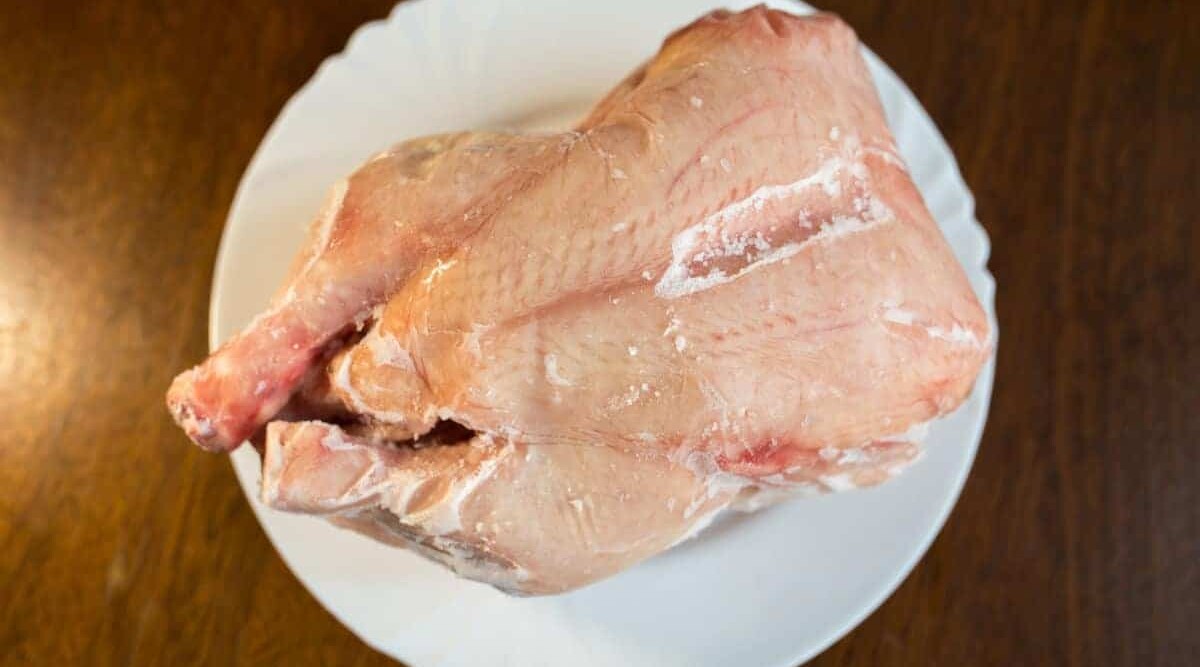
Have you ever carefully planned the menu for a party only to have a few more guests show up unexpectedly?
Sometimes life throws you a curve ball, like when the dog eats the chicken you unwittingly left by the fridge while you answered the phone.
With a lot of preparation to do and the guests arriving soon, you can’t make another trip to the store. Fortunately, you do have more, but it’s in the freezer. So you need to know how to defrost chicken fast!
A “Chicken Emergency” like this is common.
According to the USDA, the best method to safely thaw frozen chicken is by gradually defrosting it in the fridge. The downside is it could take over 24 hours depending on the size of your bird.
I’m going to show you how to thaw chicken when you don’t have a whole day to wait for it.
One big thing you should always remember is to keep your chicken safe from bacteria by keeping it out of the “danger zone,” but, I’ll get back to that in a moment.
Let’s check out a few techniques that you can use. The question is, how long you can wait?
Jump to:
- 1 The Best Way to Defrost Chicken — Submerge in a Cold Water Bath
- 2 Defrost Chicken Quickly in A Microwave (5-10 Minutes)
- 3 How to Defrost Chicken Using Hot Water (10-15 Minutes)
- 4 Not in A Hurry? How to Thaw Frozen Chicken In the Fridge
- 5 Quickest Way to Defrost Chicken
- 6 Quick Tips for Thawing Chicken
- 7 How About: Don’t Thaw It, Just Cook It? (No Time)
- 8 How to Thaw Chicken FAQ
- 9 Final Thoughts
The Best Way to Defrost Chicken — Submerge in a Cold Water Bath
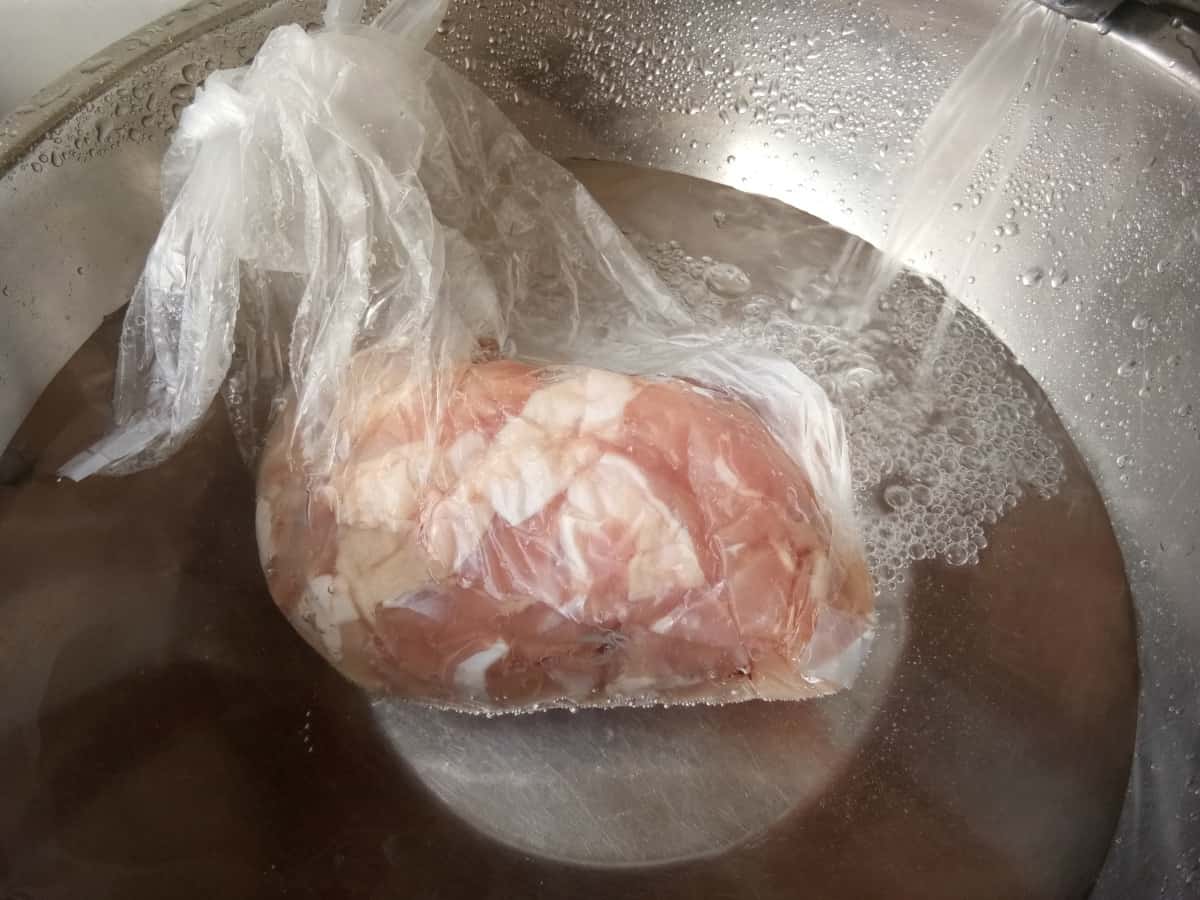
Most professional kitchens use the cold-water bath method because it is the fastest and least damaging to the meat.
This method takes only about an hour to thaw a one to two-pound frozen bird, 2 to 3 hours for up to a 4 pounder, and the same amount of time for an equivalent, tightly packed frozen package of pieces.
You can defrost a single, or perhaps two or 3 single separated chicken breasts in a water bath in 45 minutes, give or take.
To Defrost Chicken in a Water Bath
Start by filling a stockpot or a salad bowl with cold water, and fully submerge the chicken. You’ll want to change the water every 20 minutes or so with fresh cold water.
If changing the water isn’t practical, turn on the tap slightly to run a thin trickle of cold water on top to keep the water clean.
As it thaws, pull the pieces apart to expedite the process. If you’re thawing the whole bird, make sure the cold water goes inside the cavity and pull out any ice to reduce the thawing time. Obviously, the bigger the bird, the longer it will take to thaw.
Be sure to use cold, potable water in a sanitized sink or container. The purpose of using cold water is to keep the chicken out of the “danger zone.” This is the temperature range of 40⁰F (4.4⁰C) to 140⁰F (60⁰C) which is when bacteria thrive.
While it’s tempting to use warm or hot water, do not use it! The outside of the chicken can be exposed to bacteria before the inside has thawed, creating a food poisoning hazard. However, there is one exception which I’ll get into below.
Another reminder, always cook your bird shortly after thawing, and never re-freeze it unless you cook it first.
Here’s a quick video on thawing in a cold water bath.
So in summary, the cold water bath method is our preferred way. For how to defrost chicken breasts, wings or thighs, this method cannot be beaten for speed while maintaining quality.
But if you can’t wait 30 minutes? Here’s another option.
Defrost Chicken Quickly in A Microwave (5-10 Minutes)
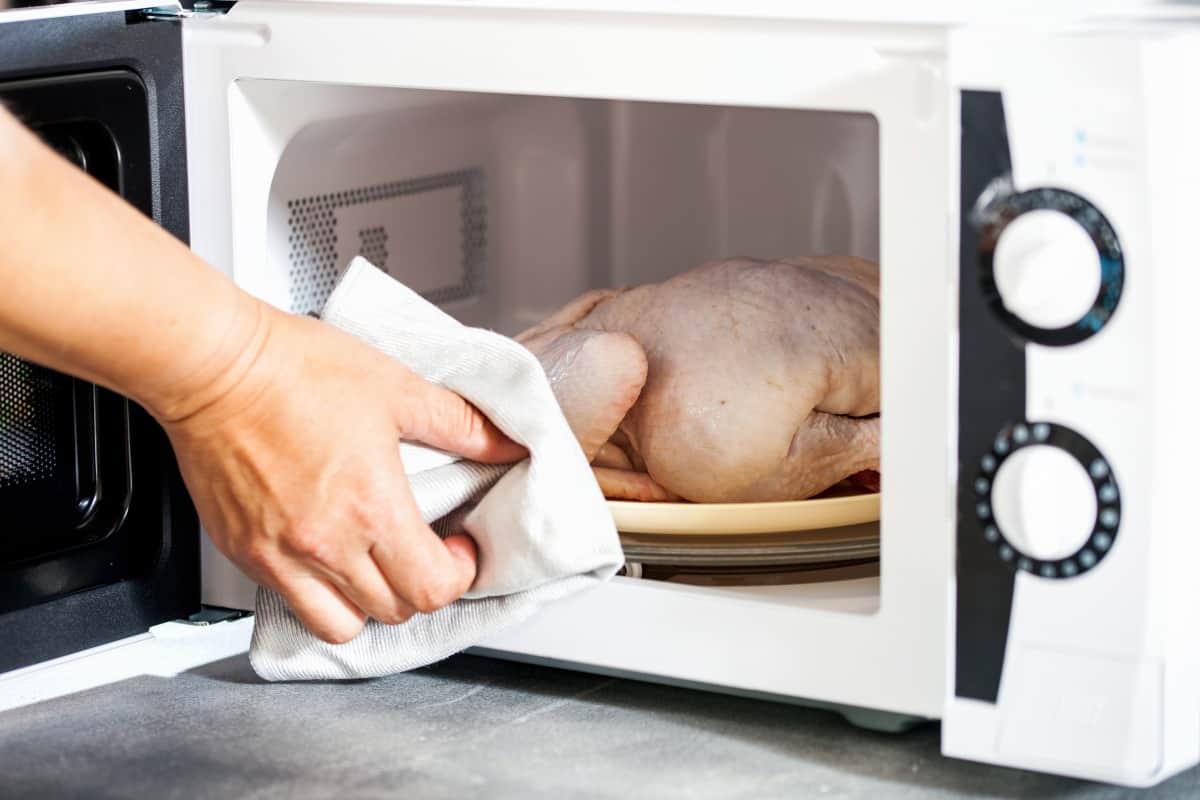
This method is quick, but you need to pay close attention as it tends to cook rather than thaw the meat, making it tough and stringy.
A microwave works by making the water molecules vibrate rapidly together, creating heat. If you leave the chicken in the microwave too long or at too high a setting, you are essentially steaming the meat from the inside out.
Check the progress of the meat periodically, and remove it as soon as it’s done.
I recommend this method for skinless breasts, but not for whole or bone-in pieces.
A microwave doesn’t thaw equally and can end up cooking parts of the meat while it’s still frozen in other places. Still, some people like this method, so I’ve found some “rule of thumb” settings you can try.
Success depends upon the power of your microwave and how well you monitor it. How long does chicken take to thaw in a microwave?
A frozen Block of Bone-in Chicken Pieces
For your average 800 watt microwave, either use the presets some models have for defrosting different weights of meat. Or…
Start with 50% power for 1 minute, then flip and continue for a second minute.
Next, separate the pieces and flip them over once more. Now microwave again at 30% power. Plan on 1 minute for every 1 1/2 pounds.
Be sure to check and flip every 30s to a minute until thawed.
A Frozen Block of Boneless, Skinless Chicken Breasts
Start with 30% power for 1 minute, then flip them over and continue for a further minute. Then separate the breasts and flip them over once more.
Next, reduce to 20% power, microwaving 1 minute for every 1/2 pound. Turn and flip every 30s to avoid premature cooking.
The microwave is one of the fastest and safest ways to defrost your chicken, but you need to babysit it, or you’ll cook it through, at least partially.
If you have too much to thaw in a microwave, or don’t want to use a microwave, but you’re still in a hurry, there’s one last emergency method.
How to Defrost Chicken Using Hot Water (10-15 Minutes)
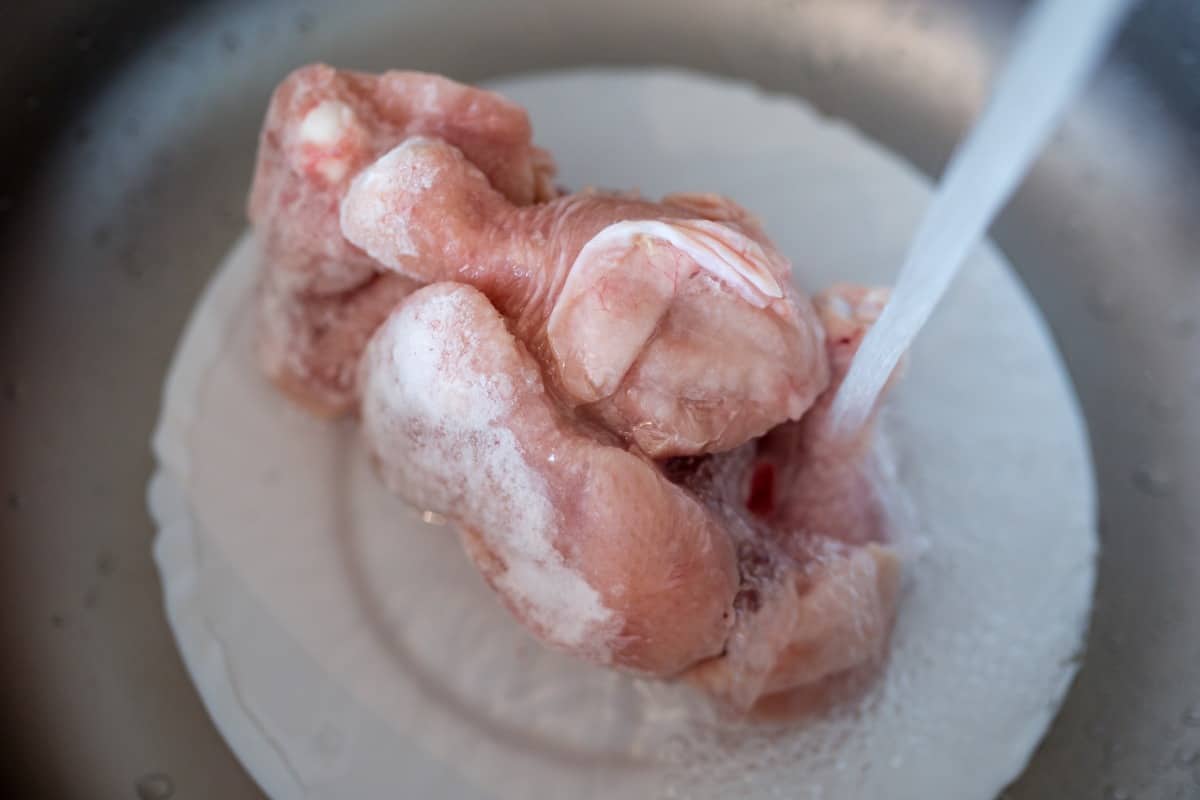
While I don’t recommend this method AT ALL, you can get away with it safely provided the chicken pieces are small, and that you cook it immediately to 165⁰F (74⁰C) or higher.
Start by running the kitchen tap water until it reaches 118-125⁰F (48-52⁰C) on your calibrated cooking thermometer (click here to learn how to calibrate your thermometers.)
Fill a sanitized sink or pot halfway with the hot water and add your chicken.
Because the frozen meat will rapidly cool off the water, you can let it trickle into your container to keep the temperature higher while thawing. Stir the water to circulate and prevent cold spots.
How long does it take to defrost chicken this way?
Smaller, cut up pieces may take only 10 minutes to thaw, but the center of a thigh-bone for example, may still be frozen.
Keep in mind that the outside surface of the chicken is exposed to bacteria, so you need to cook it immediately. But because the whole process takes 10 or 15 minutes only, the time is short enough for bacterial growth to remain within safe limits.
After thawing, monitor the internal temperature while cooking to ensure the meat reaches 165⁰F (74⁰C) before serving.
Not in A Hurry? How to Thaw Frozen Chicken In the Fridge
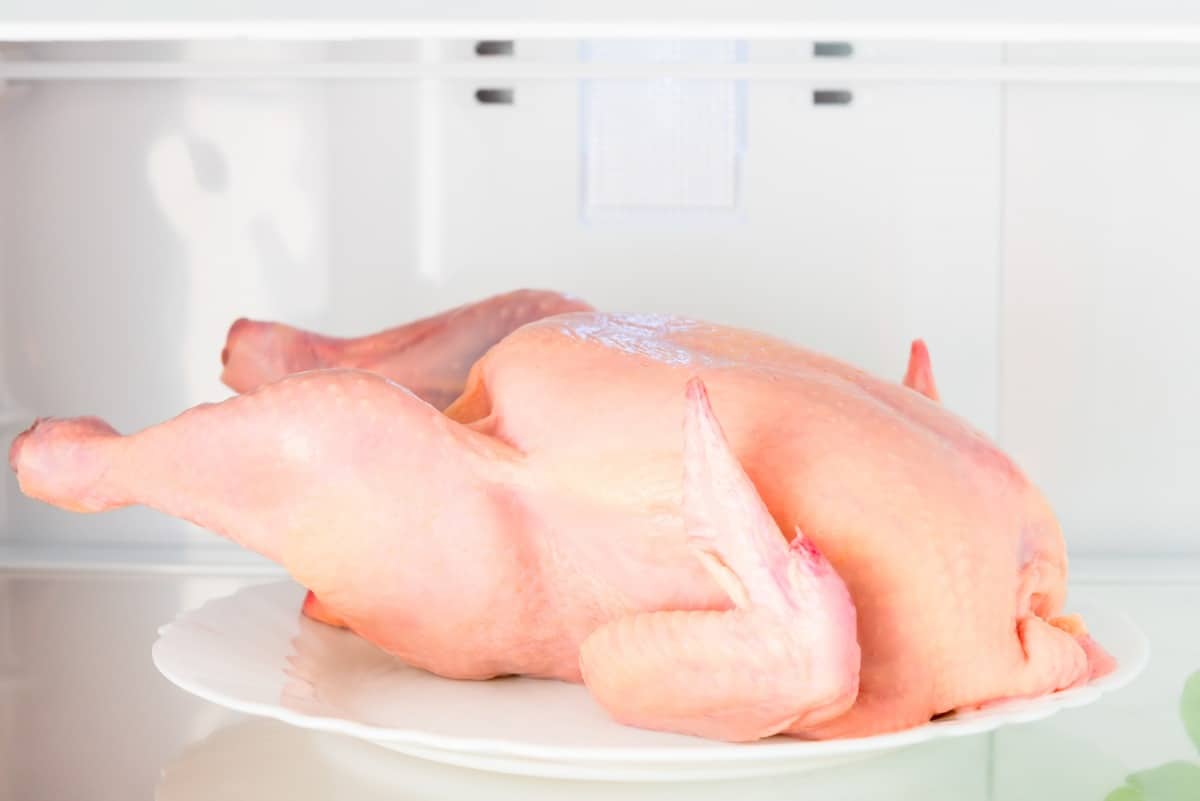
As I mentioned earlier, the safest and best thawing technique is to take your frozen food out of the freezer and back into the refrigerator.
Thawing this way takes longer than any other method, but it keeps the meat out of the danger zone in the cold environment of your fridge. The thawing process is more even, and you don’t need to cook right away.
The USDA states that thawing using the freezer-to-fridge process means you can refreeze the food if you change your mind, but I don’t recommend it. Always cook thawed foods first before refreezing to avoid possible food poisoning.
This is the longest thawing method, so you need to plan at least one or two days before cooking if you would like to thaw chicken this way.
How Long Does Chicken Take to Defrost in the Fridge?
It can take 24 to 48 hours for a whole large chicken to defrost in the fridge.
It depends on the size of the bird, or more usually the size of the frozen block of pieces you are thawing, but you should estimate a good 18 to 24 hours for a medium-sized single bird, or for a large block of frozen breasts or thighs.
You do want to give it this length of time too, because if you try to pull it out and separate the pieces earlier, that’s when you get the pieces ripping apart and being damaged, which I’m sure we’ve all impatiently experienced in the past, right?
Quickest Way to Defrost Chicken
The quickest way to defrost chicken of all the methods we’ve discussed is by using the microwave.
However, as discussed above there is always the danger of partially cooking the outer layer before the middle has defrosted, so we wouldn’t say the quickest way is the best way.
Quick Tips for Thawing Chicken
- Fast defrosting methods work best with small to medium-sized pieces.
- Whenever possible, thaw whole chicken in the refrigerator for a day or more.
- The “danger zone” for optimal bacterial growth in food is between 40 °F and 140 °F (5 °C and 60 °C). Room temperature of around 68°-70 °F (20°-22 °C) is in the middle of that zone and why you don’t want to thaw on your countertop.
- Never refreeze thawed food without cooking it first.
- Use a clean calibrated thermometer to check internal temperatures while cooking or thawing. An instant read thermometer would be best. Never use thermometer on raw then cooked meat without cleaning it first though. If you don’t have one, check out our instant read thermometer reviews.
How About: Don’t Thaw It, Just Cook It? (No Time)
Can you cook a frozen piece of chicken?
Cooking it without thawing will save you a step if you have the time and the right recipe. Dishes like stews, soups, and curries that require long slow simmering work well with this method.
You’ll need to add about 50% more time than what your recipe says. For example, if your recipe tells you to simmer for an hour, add an extra half an hour to the cooking time.
How to Thaw Chicken FAQ
What is the Fastest Way to Defrost Chicken?
The fastest way to is in the microwave. However, you have to be extremely careful not to begin cooking the outer layers, while the insides are still frozen, which is not easy to do.
We would recommend avoiding the fastest way, and go for the cold water bath method. It’s still quick, and the meat holds onto its quality throughout the process.
Is it Safe to Defrost Chicken in the Microwave?
It is, yes. However, you should only use this technique if you are going to cook the meat right away, because it’s all but impossible to keep the outer layers of the meat below 40 degrees, and bacteria will start to grow.
So you can thaw it in the microwave, and it’s perfectly safe, but only if you cook the meat right away.
How Long Does Chicken Take to Defrost at Room Temp?
I don’t know, I never do it and neither should you! The poultry will almost certainly grow large amounts of harmful bacteria by doing so as the surface of the meat becomes too warm to be safe.
Honestly, that’s all I will say on the mater: DO NOT defrost chicken at room temperature, food safety goes out the window if you do.
Can I Leave Chicken out all Day to Defrost?
No. You should never keep any meat out at room temperature for more 2 hours. That’s ANY meat, but especially chicken which is known to harbor more harmful bacteria than most other meats.
So it’s an outright no. Plan ahead if you can and defrost it in the fridge, or use the cold water bath method.
How Long can Defrosted Chicken Stay in the Fridge?
If the chicken was defrosted in the fridge, it can be kept in there for an additional day or two before cooking, according to the USDA. Interestingly, they also say you can freeze it again, though there will be some quality loss.
However, if it was thawed in the microwave or with cold water, it should be cooked right away.
How Long is Defrosted Chicken Good for?
As above, if done in the refrigerator, it’s good for 2 days according to the USDA. Though it can be re-frozen.
If thawed out using other methods, you should aim to use it right away.
Final Thoughts
The next time unexpected guests drop by or the dog steals your meal, try one of these thaw techniques for how to defrost chicken fast and safely. They work and have gotten many a chef out of a pickle.
Let me know which one you like best. You never know when they might have a “chicken emergency” and need to cook it fast.
If you have any thoughts, feedback or questions on the above, please leave us a comment below.


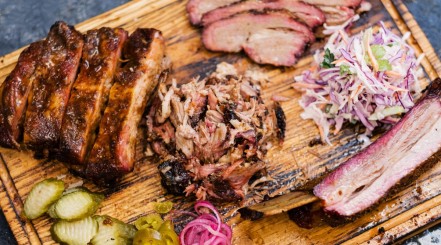
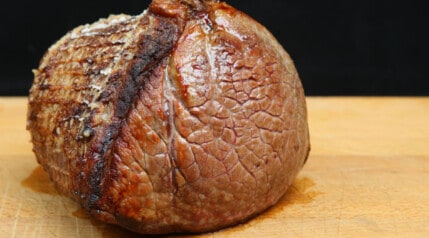
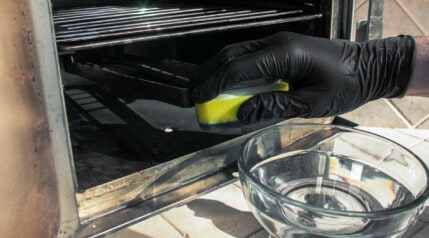
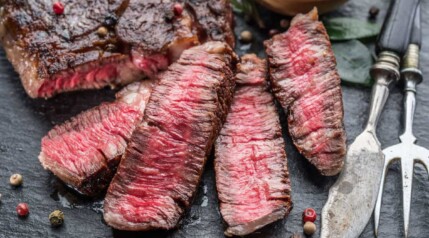
This has helped me a lot, thank you.
I’m pleased to hear it, thank you 🙂
Thank you very much for all this information! We had just put the chicken breasts in the microwave while I was reading this. And I told my husband immediately to stop that. We realized that our microwave hasn’t really been working all that great lately. Never realizing that the food is being cooked and not thawed and not equally. As our leftovers are never heated completely either. Duh…..well sometimes the elevator doesn’t go all the way to the top. We are now using the cold water method. Thanks so very much!